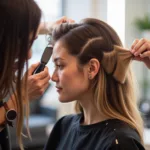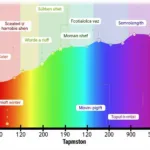Sharpening colored pencils correctly is crucial for achieving fine details and vibrant colors in your artwork. Whether you’re a seasoned artist or just starting out, understanding the nuances of How To Sharpen Colored Pencils can significantly enhance your creative process. A sharp point allows for precise lines and intricate details, while a dull point can lead to muddy colors and a frustrating drawing experience.
Why is Proper Sharpening Important?
Dull colored pencils not only limit your artistic precision but also affect the vibrancy of your colors. A sharp point deposits more pigment onto the paper, resulting in richer, more saturated hues. Conversely, a dull point deposits less pigment, leading to lighter, less intense colors. This difference can be particularly noticeable when working on detailed areas or layering colors. Proper sharpening also extends the life of your pencils, minimizing breakage and maximizing their usage.
Different Sharpening Methods for Colored Pencils
Several methods exist for sharpening colored pencils, each with its own advantages and disadvantages. Choosing the right method depends on the type of pencil, desired point, and personal preference.
Using a Hand Crank Pencil Sharpener
Hand crank sharpeners are a classic choice, offering a simple and affordable way to sharpen colored pencils. However, they can sometimes be rough on softer leads, leading to breakage. Choose a quality sharpener with a sharp blade specifically designed for colored pencils. Avoid over-sharpening, as this can waste the pencil.
Utilizing an Electric Pencil Sharpener
Electric sharpeners offer speed and convenience, especially when working with a large number of pencils. Similar to hand crank sharpeners, opt for a model designed for colored pencils. Some electric sharpeners even have adjustable settings for different point types.
Precision Sharpening with a Knife or Blade
For ultimate control and a customized point, a sharp knife or single-edge razor blade is the preferred method for many professional artists. This technique allows for creating a long, tapered point ideal for detailed work. However, it requires practice and caution to avoid injury.
Sharpening with Sandpaper
Sandpaper provides a gentle way to refine the point of a colored pencil, particularly for delicate leads prone to breakage. Wrap a piece of fine-grit sandpaper around a cylindrical object and gently rotate the pencil against it to create a sharp point.
Troubleshooting Common Sharpening Issues
Even with the best techniques, sharpening issues can arise. Here are some common problems and solutions:
- Broken Leads: This often indicates too much pressure or a dull blade. Try using a sharper blade or applying less pressure during sharpening. Consider using a sandpaper block for softer leads. You might also want to check out how to store colored pencils to prevent breakage in the first place.
- Uneven Point: This can be caused by an uneven sharpening motion. Ensure a consistent rotation and pressure when using a hand crank or electric sharpener.
- Pencil Won’t Sharpen: The lead might be broken inside the casing. Gently tap the pencil on a hard surface to try to dislodge the broken piece.
What is the Best Sharpener for Colored Pencils?
The “best” sharpener depends on individual preferences and needs. Some artists prefer the control of a knife, while others value the convenience of an electric sharpener. Ultimately, experimenting with different methods will help you find the best fit. This might be similar to understanding what the white colored pencil is for in your artistic toolkit.
Maintaining Your Colored Pencils
Proper storage is essential for maintaining the quality and longevity of your colored pencils. Keep them in a cool, dry place away from direct sunlight and extreme temperatures. Learn how to store colored pencils properly to ensure they stay sharp and ready for your next artistic endeavor.
Conclusion
Knowing how to sharpen colored pencils is a fundamental skill for any artist working with this medium. By mastering these techniques, you can achieve greater precision, vibrancy, and control in your artwork. Remember to choose the method that best suits your needs and practice regularly to refine your skills.
FAQ
- How often should I sharpen my colored pencils? Sharpen as needed, when the point becomes dull or prevents you from achieving the desired lines.
- Can I use a regular pencil sharpener for colored pencils? It’s recommended to use a sharpener designed for colored pencils to minimize breakage.
- What grit sandpaper is best for sharpening colored pencils? Fine-grit sandpaper (around 400-600 grit) is ideal for sharpening colored pencils.
- How do I prevent my colored pencils from breaking during sharpening? Apply gentle pressure and ensure the blade is sharp. Consider using a sandpaper block for delicate leads.
- What’s the best way to sharpen Prismacolor colored pencils? How to sharpen Prismacolor colored pencils often involves using a sharpener specifically designed for softer leads, or a sandpaper block.
- How can I improve my skin tones with colored pencils? Check out how to color skin tones with colored pencils to enhance your portraits and figure drawings.
- How can I create realistic flames using colored pencils? Understanding how to color flames with colored pencils can elevate your artwork and add dynamic elements to your pieces.
For further assistance, please contact us at Phone: 0373298888, Email: [email protected] or visit our address: 86 Cau Giay, Hanoi. We have a 24/7 customer service team.

